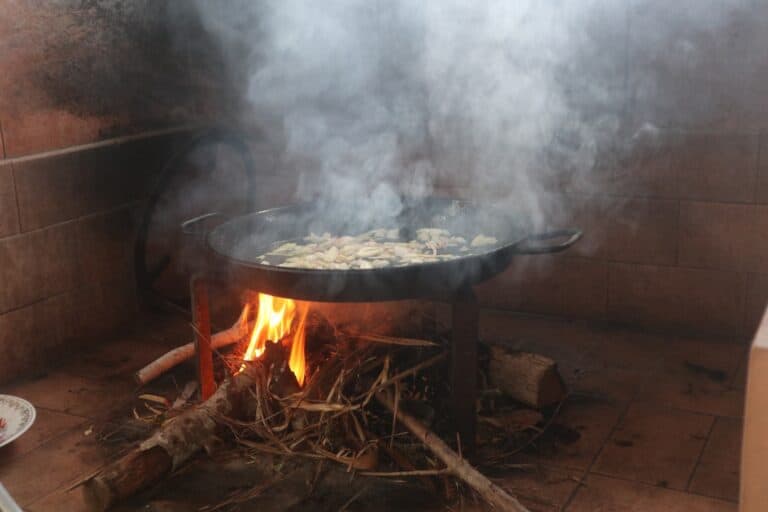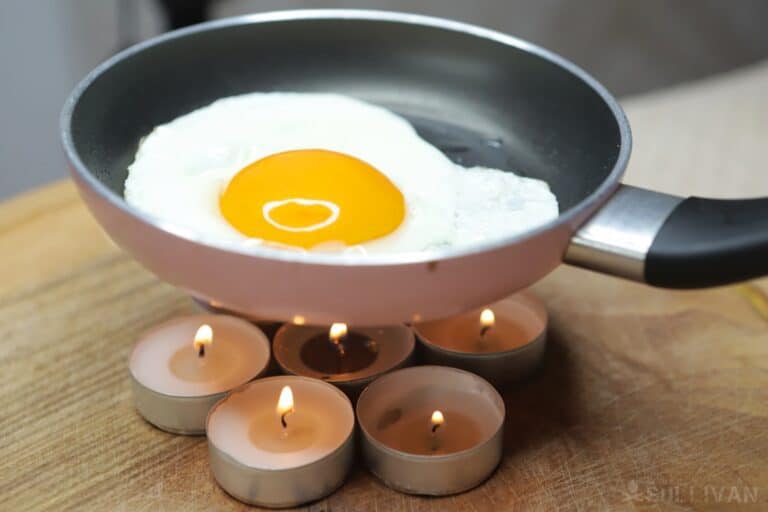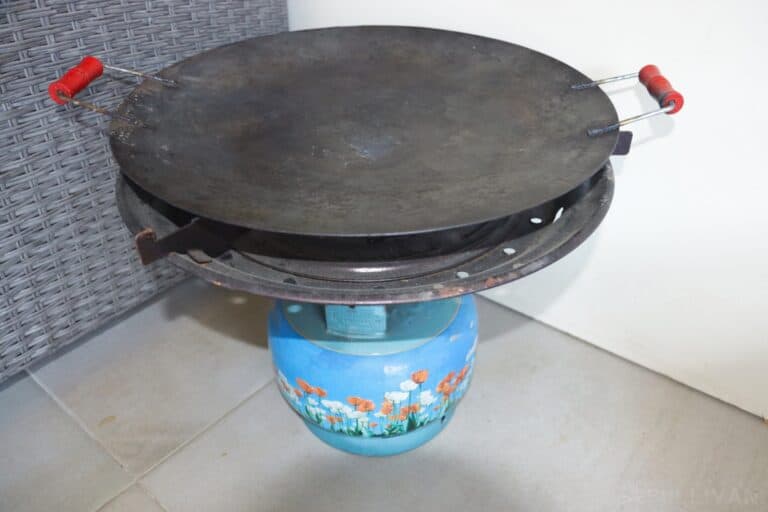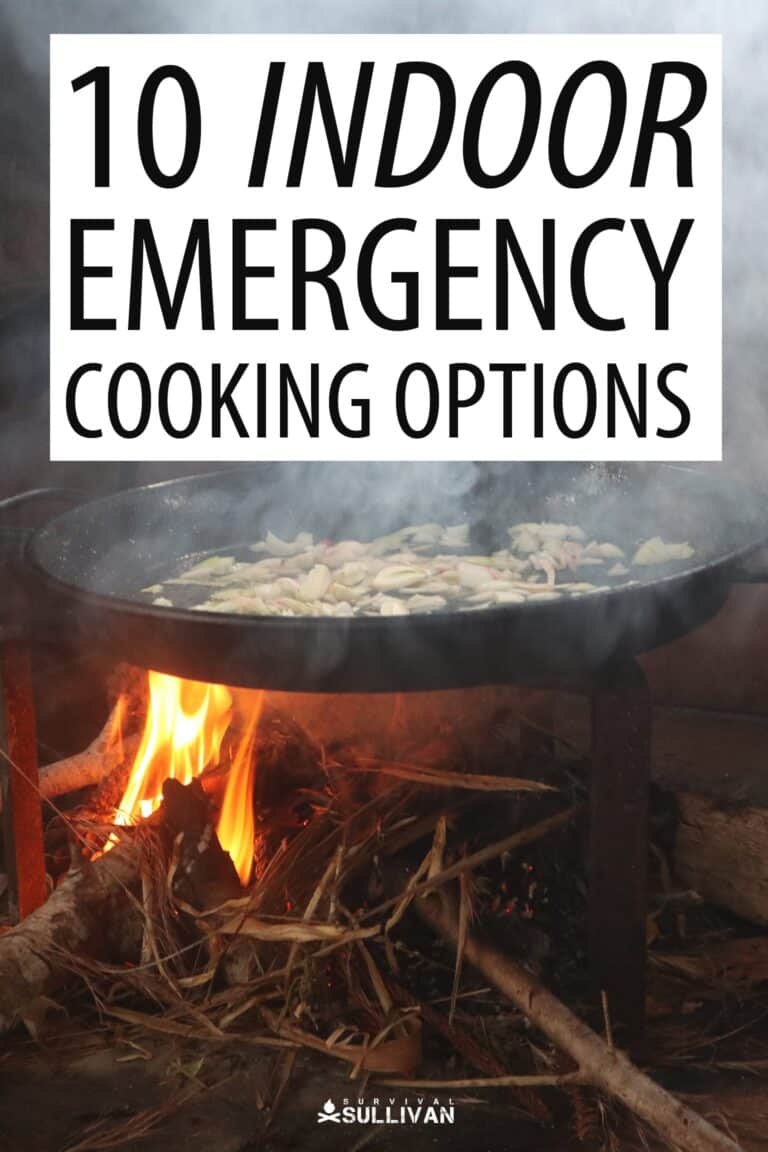Part of being prepared for survival scenarios, particularly those of long or indefinite duration, is making ready to provide ongoing calories for hard-working bodies. I’m talking about food, one of most prepper’s favorite topics…

Food is an important provision and essential to life. Despite the fact that you can go for weeks without a bite of food before you starve, you must prioritize the regular intake of calories to maintain energy levels.
When bugging in, this presents a problem unless you want to rely strictly on ready-to-eat foodstuffs. Your kitchen, likely the busiest and most important part of your home, is highly likely to be knocked offline by whatever event has seen you enact your plan.
A loss of power will cripple most kitchens, and even those people who are fortunate enough to have gas ranges cannot depend on a steady supply of it for any length of time in the aftermath.
This means that hot, prepared meals will need to be provided by other means.
Sure, firing up the outdoor grill might be an option, but then again it might not, and hostile weather will easily put the kibosh on those plans. A better option is to have several alternative means for indoor cooking.
Today we are bringing you an article that will give you the knowledge and the shopping list to keep on cooking even after disaster strikes.
Table of Contents
The Kitchen is Closed when the Power Goes Out!
As I alluded to in the opening paragraphs, most disasters that are significant enough to see you bugging in or sheltering in place are going to seriously hamper your ability to prepare hot food.
Most kitchens are entirely or mostly dependent upon electricity for operation. Take a moment to consider how many gadgets and appliances in your kitchen require electricity to function (not these, though).
Certainly your microwave, but also your coffee maker, electric kettle, food processor, and probably your oven and stovetop.
Your toaster oven definitely does, and any other heating or cooking appliance that sits on the countertop similarly relies on electricity, everything from your slow cooker to your dehydrator.
Yes, you might be one of those fortunate souls that have access to a gas range and oven which will provide you a little bit of insulation for cooking against the loss of electricity, but even that is highly fallible.
Unless you have a propane or natural gas tank on your property that you draw from directly, the public supply of that fuel for your oven or stove is highly dependent upon an incredibly intricate network of pipes, installations, personnel, and support facilities to make delivery possible.
Anything that disrupts electricity is likely to disrupt components in this network, and some really serious disasters could be severe enough to damage the distribution Network itself.
Not for nothing, one of the first things that authorities will shut down in the wake of a really serious catastrophe is natural gas and propane supplies with the idea being this will help prevent an explosion, subsequent fire, and further calamity.
That means that smug certainty in the continued operation of a gas appliance in the aftermath of an event is probably misplaced.
No, the bottom line is that if you were going to depend on any appliance whatsoever for heating or cooking food you’re going to have to provide it yourself, from front to back.
Alternate Indoor Cooking Options Demand Caution
The good news is you have plenty of alternate options for cooking indoors that are viable for long-term sustainment even in the absence of electricity or natural gas supplies.
The bad news is that all of them, with scarce few exceptions, demand significantly more care and attention from you in order to prevent accidents, accidents that might have severe consequences including burning your house down or losing your life.
This is because modern kitchen appliances and setups are designed with safety and certainty in mind, not just convenience. any of these improvised indoor cooking options, even if they are purpose-designed for cooking in particular, entail special risks.
First and foremost, fire, or rather accidental fire, is always going to be the biggest and potentially deadliest threat. Open flames and extremely hot surfaces when operating can set objects or even your house on fire.
Considering that a small accidental blaze can turn into a fully involved raging inferno in a matter of minutes, you’ll need to be prepared with properly rated and tested fire extinguishers close at hand whenever you are using any of these methods.
Second, and probably the most insidious, sneaky risk you’ll take on is that of carbon monoxide poisoning. Anything that burns releases a certain amount of carbon monoxide gas, and this carbon monoxide or CO gas is odorless, colorless, and tasteless, but is nonetheless quite deadly once it builds up in your body.
These gases take effect slowly, usually making you feel a little off or sickly before progressing to severe symptoms of pain and disorientation and then finally unconsciousness with death close behind.
Adequate ventilation is absolutely essential for safety when using any of these methods, though some are riskier than others. Make sure your carbon monoxide detectors are properly placed and have battery backups!
Lastly, you’ll always have to worry about a straight-up burn hazard using any of these methods. Most of them involve blazing hot surfaces or open flames, and a couple of them burn so hot that the flames are effectively invisible or difficult to detect compared to what you are used to.
This makes proper placement and supervision essential for safety, and you’ll need to make doubly sure that they are extinguished and cool before you turn your back on them.
As always, think things through, have a plan for dealing with accidents and stay on your toes when cooking with any of these methods! That’s it for the safety brief, time to get on to the list.
Useful Alternatives for Indoor Emergency Cooking
Candles
Believe it or not, candles are a viable method of cooking simple foods and heating others, and if you are a good prepper who has been around the block you probably already have a sizable stash of candles on hand to serve as supplementary light in situations where the power is out.
They generally don’t work quickly and you sure aren’t going to be doing any substantial baking or anything like that with them, but they can get the job done.
The trickiest part of using candles for heating food and cooking is simply getting your cookware setup over them. You’ll need to use a rack or holder of some kind that will place your vessel above the flames but not so close that it risks snuffing them out.
My favorite method for doing this is actually to place the candles close together on a pan or in a bowl as appropriate and then place them in the bottom of your oven before using the ovens built in racks to situate your cookware above the candles.
Obviously, the more candles you can throw at the equation, the quicker your food will be heated, but this isn’t necessarily the best use or most efficient use of candles for the purpose.
That being said, candles are plentiful and cheap, so if you already have abut there is no reason why you can’t put them to use in this way.
Tealight Oven
The tealight oven takes the concept of candle-based cooking and levels it up a couple of notches.

A tealight oven is actually a purpose-made construction that features a removable rack designed to hold several, small tea light candles at the bottom. depending on the size of the oven, it might hold between six and 20 or even more.
Compared to using candles in an improvised way, the tea light oven is designed to maximize the heat output from these tiny candles. It traps the radiant heat and reflects the infrared energy from the flames onto your food, cooking it from all sides at once and even allowing you to do small-batch baking.
Even better, these contraptions are designed to be safe to use and like burning candles on their own they emit virtually no significant amount of carbon. you might have to take care that they do not scorch any surface you set them on, but this is a problem easily solved by using a trivet or some other protective implement.
Fireplace
If your home features a real, built-in fireplace you are in luck because you are basically ready to cook in it with just a few additional implements to help you.
You might or might not be surprised to learn that it has been the fireplace that has long been the primary installation for cooking in homes around the world for centuries.
By using a rack, stand, or something else to hold your cookware over or near the flames you can whip up pretty much anything as long as you are accomplished cooking using fire. Nothing is out of the question, including bread, and things that are typically prepared in large pots are perfect and easily done.
Note that you might need long-handled implements to help you interact with whatever you are preparing and safely handle the now-screaming hot cookware.
Something else to keep in mind is that working close to a fire is a challenge and safety risk unto itself. You must be prepared for serious accidents should you spill anything on or near the fire. Grease and oil can flare up terribly and quickly get out of control.
Make sure you have safety countermeasures on hand, and if you plan on using this method for cooking you must have your chimney regularly inspected and maintained so you can count on it when the time comes.
Wood Stove
Another time-tested option for cooking, and one that many people still rely on in remote habitations and elsewhere around the world today, the wood stove is an invaluable way to keep your home warm and also get some cooking done so long as you have a solid supply of firewood.
A wood stove is an option that will need to be installed with proper ventilation in mind, but so long as you already have one in your home you’re pretty much ready to cook with it.
Wood stoves come in a couple of varieties, and older wood stoves that were designed primarily with cooking in mind or for cooking and heating likely already have wide, flat tops that are perfect for cooking on.
More modern versions might not be set up and quite the same way, designed as they are principally for heating, what was just a little bit of adaptation you can make that screaming hot surface work for you.
A wood stove that is properly maintained and installed is quite efficient, but like any other wood burning appliance carbon monoxide is a major concern.
If the exhaust system or flu pipe is leaky or malfunctioning carbon monoxide can build up inside your home very quickly, so like fireplaces make sure you stay on top of inspection and maintenance.
Alcohol Stove
Alcohol stoves have long been the choice contingency cooking and survival option for mariners and other people who want hot burning, reliable performance with the absolute minimum of fuel storage worries and emissions.
Alcohol stoves are typically compact, highly reliable, and easy to use, and high-test alcohol fuels have much to commend them for survival purposes.
Compared to other liquid fuels, denatured alcohol, and other suitable fuels are easy to handle, very long-lasting and efficient. They also have minimal risks in handling and are comparatively easy to clean up. In use, alcohol stoves run hot, really hot, and that is both a perk and a flaw in this case.
There is very little that an alcohol stove cannot accomplish when it comes to cooking unless you deliberately need a low-temperature application, but perhaps more germane to our purposes is the fact that alcohol stoves usually burn with a flame that is invisible or nearly so, so you need to be careful when it is in operation and ensuring it is extinguished.
Additionally, alcohol stoves typically emit very little in the way of carbon monoxide, but it is still potentially a threat, so now as always practice proper ventilation procedures.
Electric Burner
Your electric stove might be down, but if you have access to on-demand power generation or storage, electric cooking might still be an option for you.
At first thought, this might seem highly counterintuitive: if you can generate your own electricity, why not just use your electric stove?
A fair question, but I would counter with the notion that an electric stove is far from power efficient under the circumstances, and unless you have a whole house generator or integrated battery backup system that will make use of your home’s existing wiring, you won’t have an easy way to plug an electric stove into a generator.
On the other hand, if you use a simple, single electric burner that will plug into a conventional outlet and prove more than capable of boiling water or heating up a pot of food, you can make the best possible use of a now sharply limited power supply and still cook food more or less normally, though on a limited scale.
Perhaps the best part of using an electric burner under these circumstances is it you won’t have to worry whatsoever about potentially deadly carbon monoxide emissions, although those blazing hot coils remain a significant burn and fire hazard, it won’t be anything you aren’t used to dealing with already if you are an accomplished home cook!
Solar Cooker
You may already be familiar with the concept of a solar cooker, sometimes called a solar oven, and wonder why it is showing up on a list of indoor cooking options.
After all, don’t these ovens require clear access to the open sky in order to operate, dependent as they are on the sun’s rays? Yes, they do, but they may still be used indoors so long as they can be placed in a way where they receive adequate sunlight.
The solar cooker is itself little more than a sealed metal box with a grate or rack inside and a gasket, transparent door not unlike your oven in your kitchen.
When solar radiation enters through that transparent door it is reflected onto the food from all sides and also raises the internal temperature significantly, easily hot enough to roast meat or bake bread.
So long as you have plenty of windows or skylights in your home that reliably get full sunlight, you can place your solar cooker accordingly and it will work pretty much as well as it would outside so long as those windows are clean.
Glass isn’t much of an impediment to sunlight! Now, solar ovens get hot enough to cook meat, and that means they’ll get hot enough to badly burn you or scorch a surface that they are carelessly set on, so make sure you take all necessary precautions when using one of these indoors.
Flameless Ration Heaters
Anyone who has served in the military is doubtlessly already familiar with these interesting gadgets, but for those of you who have not, or who have never partaken of the culinary delight that is the modern MRE, allow me to elucidate.
Flameless ration heaters are basically chemical packets that will react with moisture, specifically the application of water, to generate a considerable amount of heat in an exothermic reaction.
Typically, this is enough to boil the water, or nearly so, and generate plenty of steam. the small flameless ration heater found in an MRE is potent enough to easily and thoroughly heat up a large packet of stew or similar entrees, and on the market today we have access to larger versions it looks sort of like a modestly sized lunch box.
All you need to do to make use of these heaters is place the food that you want to heat or cook inside in an appropriate vessel, and the prescribed amount of water or follow the instructions on the heater if they say otherwise, and then wait for the heater to finish.
Your food should be piping hot or nearly so by the time it is done. although capable of burning you significantly if handled carelessly, these heaters are generally quite safe and operate with no open flames or generation of carbon monoxide.
Canned Heat
Canned heat is a type of gelled alcohol fuel that is designed for long-life burning in order to facilitate food service in indoor or outdoor settings.
You have probably seen these if you’ve ever been to a wedding reception or other gathering or a buffet of food in large metal steamer trays was set out for guests. Those shiny metal pots you see beneath the trays are canned heat of one brand or another.
Efficient and generally affordable, canned heat has much to commend it for cooking and heating food, but you’ll need to be careful about what variety you buy.
Depending on the size and type, canned heat will burn anywhere from 2 to 5 hours, and typically blazes with a nearly invisible flame typical of alcohol fuels though sometimes it might appear yellow-tinted.
As such, make sure you are careful when handling, and to be absolutely, positively sure they are extinguished and cool before handling or disposing of them!
One last thing. Canned heat is available for indoor, indoor/outdoor, and outdoor uses, with the latter variety typically offering higher performance but emitting carbon monoxide, while the type that is specific for indoor use isn’t quite as effective but emits basically no harmful gases, rendering it safer.
There’s also an indoor/outdoor variety that sits neatly between the two.

Camping / Field Stoves
Chances are any preppers reading this along with campers, hikers and other outdoor personalities are already familiar with, and likely already have a camping or field stove. these tiny burner apparatuses run off a variety of liquid fuels depending upon the type, anything from propane to white gas and more.
Compact, efficient, and designed for maximum portability, these can nonetheless be put to use indoors when used with caution.
Although more than capable of bringing water to a boil or heating up a small pot of food and fairly short order these stoves are limited when compared to other options on this list. you won’t be baking anything on them, and preparing food for anything more than a couple of people is going to be a lengthy and aggravating affair.
Beyond that, there is the obvious drawbacks of a blazing hot, focused, and open flame on a comparatively rickety device that is designed to be placed on bare ground, not your countertop, and definitely not on your floor.
You’ll need to employ this option with caution, and also be alert to carbon monoxide hazards, but assuming you have the nerve and pay attention there is no reason why your camping stove can’t be put to use in your kitchen.
Conclusion
Most major disasters and long-term bug-in situations will see you denied the use of your kitchen as normal. You’ll still need to eat, and unless you have a limitless supply of ready-to-eat food with the stomach to subsist on it, you’ll still need to cook.
With the right equipment and know-how, you can utilize alternate indoor cooking solutions during a long-term survival situation to effectively keep your kitchen in operation during such an event.


Tom Marlowe practically grew up with a gun in his hand, and has held all kinds of jobs in the gun industry: range safety, sales, instruction and consulting, Tom has the experience to help civilian shooters figure out what will work best for them.

I have cases of “liquid heat” available. Is this an option for cooking? Would these be able to boil water for cooking? If so, how many canisters would be required? I have cooling racks also. We lost our electricity last year but we were able to use the burners by turning on the gas and lighting them with a match . But if we don’t have gas I was thinking we could use them on the stove top. What are your thoughts?
That will work well in the camping/field stoves mentioned in the article. It should also work well in the aluminum can alcohol burners described in many YouTube videos.
What about a kerosene stove
Seams like the best solution to me
I stocked up o 2 butane stoves and 50 cans of butane work like a charm, can also be used for heat in an emergency.
If your backup cooking system(s) of choice might produce Carbon Monoxide
(CO), purchase a cheap CO detector, similar to a smoke detector, and sufficient batteries to keep it in operation.
Remember that CO does not sink to the floor, it mixes with the air in the room. You can keep the detector on a counter and a yard or so away from the source. If the detector squawks, open a door or window to increase air replacement in the kitchen.
P.S. I’m not an expert on the subject…don’t listen to me. Do your research and read the CO detector directions.
One more thing. Consider modifying your vent hood above the stove to accept the addition of a 12 volt, muffin type exhaust fan. You’ll need a charged, auto type battery and leads (plus solar charger). Your kitchen will stay warmer/cooler without the need to open doors or windows.
those cheap 25-30$ green chinese kerosene stove/heaters do work,they use 100% cotton wicks ,so you can burn kero or diesel..simple kero/diesel stove can be made from tin cans and cotton wicks, cheap mops are cotton , as is some twine and rope ..coleman makes a unleaded gasoline stove, one burner or 2..dont even think of making a gasoline stove/heater, you will blow yourself up..if outdoors you can burn gasoline in a metal pan of kitty litter,or dry sand,,lots of black smoke, will need a breeze to carry away the smoke while your cooking..oil and water can be dripped down in seperate metal tubes ,mixed in a pan for burning,plenty of smoke..